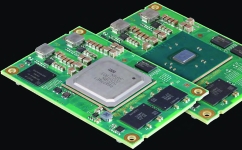

In building automation, more and more often-touch displays with integrated embedded computers can be found – from automated parking systems to elevators or home climate control. Most of the time, these devices are waiting to be used, but that is no longer enough in certain situations. For example, pure touch operation is a problem when someone has their hands full, not to mention today’s stricter hygiene requirements.
Hence, voice recognition is the next logical step, with Siri and Alexa having already paved the way. The decisive factor, however, will be image recognition, as it will allow terminals to recognise their users even before they stand in front of them and thus make it possible to start a personalised and situationally adapted dialogue. Consider as an example an elevator that recognises a passenger with a sports outfit and asks whether it should stop at the building’s fitness centre.

This proactive approach of operating terminals exudes a sense of luxury and can contribute to the overall quality and rating of a building, not only in the case of high-priced residential properties but also for hotels.Buildings housing public services departments also need an efficient visitor and guidance system that prevents people from wandering helplessly through endless corridors.
The driver of this development is global urban growth and with it a steadily increasing demand for ever more intelligent solutions for building automation.

The electronics for these proactive helpers must include the functionality of an HMI terminal (touch and graphical functions) as well as the interfaces to the application. Beyond that, however, numerous other capabilities are also required, such as:
• Audio and video streaming in case you want to be connected to a real person.
• Communication channels to other terminals for seamless user guidance.
• Powerful image processing for individual recognition and observation.
• Authentication by voice and image.
• Consistent security mechanisms to give hackers no chance.
• Reliability even under adverse conditions.
• Long-term availability of both hardware and software.
• Energy efficiency.
• Installation without high cooling costs.
• Cost-effectiveness to allow almost omnipresent use.
• Scalability to meet the various challenges within buildings.

Powerful embedded modules with integrated graphics
With its new TQMaRZG2x modules, TQ-Systems (TQ) offers a suitable basis for the next generation of HMI devices. At the heart of these modules are the RZ/G2 processors from Renesas, which scale pin-compatibly from dual-core (Arm Cortex-A57) up to double quad-core (Arm Cortex-A57 and -A53) microprocessors.They are supported by a 3D-GPU (PowerVR) for demanding graphics and image processing, including an H.265 decoder for higher-quality image transmission than H.264 allows, even with limited bandwidth. This means that nothing stands in the way of a livestream with a human contact, be it for an intercom system or a connection to a call centre.
In addition, the RZ/G2 processors offer reliability through the most consistent use of error correcting code (ECC) in an embedded MPU; all internal and external memory interfaces are designed for this. In addition, the L1 and L2 caches are also implemented with ECC. The memory of the module offers up to 8 GB LPDDR4, up to 256 MB Quad-SPINOR Flash, up to 64 GB eMMC and an optional 64 Kbit EEPROM. Thus, enough memory is provided even for very demanding HMI applications.
Consistent security and long-term certainty
The RZ/G2 microprocessors are also convincing when it comes to code and data security. They enable a secure, trustworthy platform through numerous functions such as Arm TrustZone partitioning, cryptographic accelerators, secure key generation and storage, secure booting and the establishment of a root of trust. In addition, the use of voice and facial recognition for security mechanisms is possible. These are important criteria to allay the security concerns of users and owners.
What no architect, building operator or resident wants is for an electronic concierge to have the same update cycles known from the PC and consumer electronics world. This would result in the frequent inability to use the device while an update is being installed, only to then find out after a few years that the latest ‘improvements’ no longer run properly on the existing hardware. Renesas therefore relies on the Civil Infrastructure Platform (CIP), a Linux distribution for long-term support designed especially for infrastructure and industrial systems. The Super Long-Term Support (SLTS) kernel maintained by CIP is designed for a period of use of at least 10 years. This also includes security measures.
As a long-term available basis for next-generation HMI systems, the TQMaRZG2x modules provide interfaces for a wide range of building automation applications: LCD and dual camera interfaces; Ethernet, USB and serial ports; CAN, SD-card interface, PCIe, I2C, SPI, I2S, GPIO and SATA (RZ/G2N only). The signals are made available to the carrier board via two 220-pin connectors. With dimensions of 77 x 50 mm, the module is smaller than a credit card and thus fits behind a small display together with most carrier boards.
These features, together with the low power consumption of the module (6 W typical) simplify installation. The standard temperature range of -25°C to +85°C also allows for the outdoor use of an electronic concierge. For particularly frosty environments, an extended temperature range of -40°C to +85°C is available.
With all these capabilities, TQ’s TQMaRZG2x modules are ideally suited for use in predictive HMI systems generally, not exclusively within building automation. They boast all the necessary functions and features users expect and are supplied according to a favourable cost structure.
| Tel: | +27 21 975 8894 |
| Email: | [email protected] |
| www: | www.ri-tech.co.za |
| Articles: | More information and articles about Rugged Interconnect Technologies |
© Technews Publishing (Pty) Ltd | All Rights Reserved